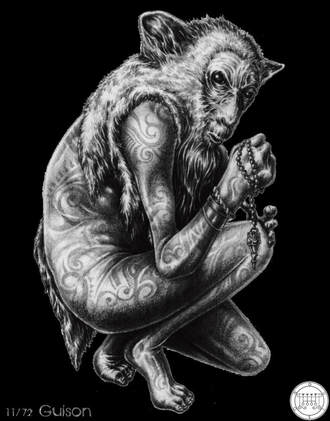Blue Demon Gusion
By James Donahue
Johann Wier created a mystery when he wrote in 1583 that the Eleventh Goetia Spirit Gusion (spelled Gusoin and Gusoyn in Wier's text) appears "in the forme of a Xenophilus."
This word does not appear in the dictionary, which is not surprising because Wier's Early English text seemed to have its own way of spelling. Yet every description of this spirit since Wier has used the same phrase, without ever bothering to try to find out its meaning.
The problem is that there are various words that come close to Xenophilus, but all have different meanings and all might apply to Gusion.
An Xenopus, for example, is a puffy, South African frog that comes in a variety of colors. One artist’s image of this spirit looks like a somewhat puffed-up blue individual with tiny eyes and mouth.
The word xenomophoric means having an unusual form caused by pressure from something within. In other words, it is puffed out?
But then the word xenophobis means to have a strong dislike of foreigners.
All three words might describe this particular demon.
The web site Gods and Monsters states that ancient writers have described Gusion as looking like a baboon, but those who have summoned and observed this demon say he appears “more like a bright, bluish creature with narrow eyes and mouth.” The writer said there is so much light around him that it is difficult to see much of him.
Wier says Gusion is "a great duke, and a strong (one). . . he answereth all things, present, past and to come, expounding all questions. He reconcileth friendship, and distributeth honours and dignities, and ruleth over (45) legions of (devils)."
Seagrave adds that "Gusion appears in the guise of a mature and strong man in a saffron robe. He speaks softly and his advice always seems good in consequence."
By James Donahue
Johann Wier created a mystery when he wrote in 1583 that the Eleventh Goetia Spirit Gusion (spelled Gusoin and Gusoyn in Wier's text) appears "in the forme of a Xenophilus."
This word does not appear in the dictionary, which is not surprising because Wier's Early English text seemed to have its own way of spelling. Yet every description of this spirit since Wier has used the same phrase, without ever bothering to try to find out its meaning.
The problem is that there are various words that come close to Xenophilus, but all have different meanings and all might apply to Gusion.
An Xenopus, for example, is a puffy, South African frog that comes in a variety of colors. One artist’s image of this spirit looks like a somewhat puffed-up blue individual with tiny eyes and mouth.
The word xenomophoric means having an unusual form caused by pressure from something within. In other words, it is puffed out?
But then the word xenophobis means to have a strong dislike of foreigners.
All three words might describe this particular demon.
The web site Gods and Monsters states that ancient writers have described Gusion as looking like a baboon, but those who have summoned and observed this demon say he appears “more like a bright, bluish creature with narrow eyes and mouth.” The writer said there is so much light around him that it is difficult to see much of him.
Wier says Gusion is "a great duke, and a strong (one). . . he answereth all things, present, past and to come, expounding all questions. He reconcileth friendship, and distributeth honours and dignities, and ruleth over (45) legions of (devils)."
Seagrave adds that "Gusion appears in the guise of a mature and strong man in a saffron robe. He speaks softly and his advice always seems good in consequence."
